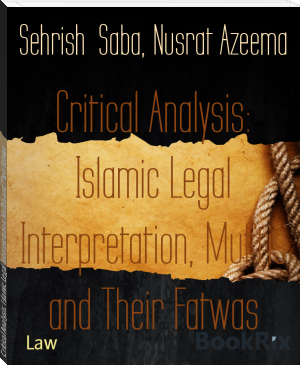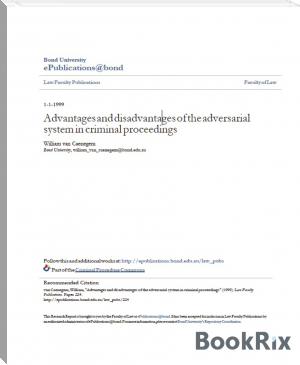Critical Analysis: Islamic Legal Interpretation, Muftis and Their Fatwas by Sehrish Saba, Nusrat Azeema (romance novel chinese novels txt) 📕

Read free book «Critical Analysis: Islamic Legal Interpretation, Muftis and Their Fatwas by Sehrish Saba, Nusrat Azeema (romance novel chinese novels txt) 📕» - read online or download for free at americanlibrarybooks.com
- Author: Sehrish Saba, Nusrat Azeema
Read book online «Critical Analysis: Islamic Legal Interpretation, Muftis and Their Fatwas by Sehrish Saba, Nusrat Azeema (romance novel chinese novels txt) 📕». Author - Sehrish Saba, Nusrat Azeema
Chapter ten states about the child marriage in seventeenth century Palestine, the same practice was also prevailing in China, Japan, India, Babylonia, Rome, Athens, among Jews and Christian Europe during the middle ages along with pre-modern Muslim societies. According to writer, the difference of the views between pre-modern Muslim societies and modern western standards lies in the definition of the childhood. The fatwa in the chapter is presenting the sketch of Muslim marriage practice in Palestine during the seventeenth century. The fatwa also provide an insight into the different aspects of child marriages, the procedure involved, the proportion of boys and girls involved, the ages of marriage partners, the motives behind such marriages and the problems arising out of it. It also reflects the social circumstances and daily happenings that judges and muftis of the time had confronted.
Eleven Fetvas of the Ottoman Sheikh ul- Islam ‘Abdurrahim
Chapter eleven consists of eleven fatwas, given by the ottoman sheikh ul- Islam’ Abdurrahim. Writer of the chapter while describing the history of the fatwas given by sheikh-ul-Islams, mentioned that from the half of the sixteenth century until the end of nineteenth century, collections of the fatwas issued by sheikh-ul-Islam formed a distinctive branch of legal literature. The compilers usually grouped the fatwas under chapter headings. Each chapter consisted on further headings and subheadings according to the subject matter.
Under the command of sheikh ul- Islam Ebassu’ud, in sixteenth century the fatwa office was established as the issuance of fatwas became a routine procedure during his time.
In this chapter, the writer discussed the fatwas from the compiled collection of the fatwas of Abdurrahim, who held office as sheikh ul- Islam from 1715 to 1716. This is illustration of series of fatwas grouped together in the manner mentioned by the writer before.
The issue discussed under these fatwas is related to the legal status of mother and child when a man produces offspring by a female slave belonging to his wife. This status determination is an important feature of Islamic family law.
Abdurrahim has eleven fatwas on this problem that’s why the writer chose to give this name to the chapter. The salient feature of Ottoman fatwas is their secrecy as the identities of original questioner; the officials who drafted the question in its existing format and the protagonists in the case are all usually kept secret. Another feature of the fatwas of this era is their conciseness both the questions and answers contain nothing except the essentials of the case.
The writer very carefully pointed out the pros and cons of these fatwas, according to his view the element of conciseness provided a great clarity to the point of law illustrated in the fatwa whereas the element of secrecy gave the generality to the fatwa which is contradictory to the usual fatwas, which applies to particular cases only. For a modern reader these two features are having drawbacks, as these had obscured the processes whereby these fatwas came into existence. This made impossible for the writer to comment on the social and legal background of the fatwas with certainty mentioned in the chapter.
The writer presumed the situations in which these fatwas may had been forwarded by qadi / judge to the sheikh ul- Islam for his opinion and put light upon the process of formation of legal precedents in Ottoman law. The judgment given by the Qadi/ judge was limited to the case at hand whereas, the fatwas had more general validity and would provide Qadi with authoritative guidance in similar cases in the future, means had precedential value.
The Fatwas Of Condemnation
This chapter is the start of early modern period which is part three of the book. It contains the fatwas of condemnation. Fatwas of condemnation includes those fatwas which are issued to banish the troublesome elements intended to unravel the unity among the Muslims and to drive them away from the right path.
The fatwa discussed by the writer in this chapter is about Muhammad b. Ali al- Sanusi, a man who belongs to a group of those who deflect the people from the true path and promote high individualism and hatred toward taqlid[1]. This independence of approach cast them in bad odor within the Ulema of their day. The review of the charges levied against al- sanusi in the fatwa was discussed in the chapter while divided into two principle categories by the writer. One is that several of teachings of al- Sanusi are denounced as dangerous innovations and the other is that some of his ritual practices of the brotherhood were denounced as having departed from the rigors of Maliki convention and pure path of Islamic Shari’a.
The writer opines that the fatwa discussed in the chapter and other fatwas of the same classification were result of weaknesses of Ottoman authority and rapid rise of European activity in Africa, India and the Middle East. According to analysis of the writer, through his use of Ijtihad, which according to other ulema’s was not allowed after its closure but in views of al- Sunasi was common property of all Muslims of high learning, al- Sunasi tried to establish an entente between Sufism and fiqh, but failed in his effort like his predecessors, as his talents were not given value by the official ulema’s of his time.
[1] Following the opinion of another within a madhhab, or school of law
Fatvas as Asymmetrical Dialogues: Muhammad Karim Khan Kirmani and His Questioners
Chapter thirteen is dealing with fatwas as asymmetrical dialogues: Muhammad Karim khan Kirmani and his questioners. The writer while giving historical background of the topic mentioned that since the institutionalization of Twelver Shi’ism as the religion of the Iranian state in the Safavid period (1507-1722), the ulema have been a heterogeneous sector of society representing different theological and political positions. Ulema not only saw frequent criticizing and contending with one another on different theological issues but also struggling to attain positions of authority.
In the sixteenth century, two groups emerged having contradictory views regarding the function of mujtahid. One known as Usuli’s were of the view that mujtahis is a guide for the community and can apply his personal interpretation to the texts. Usulis were more flexible regarding authority of the mujtahids, this flexibility allowed the religious leaders of the time to express political opinion and thus to influence the worldly matters. Whereas the other group Akhbaris believed that the only authoritative sources are Quran and Sunnah.
The writer discussed few fatwas of the Muhammad Karim khan Kirmani and through these fatwas analyzed the historical and social context of these fatwas along with evaluation about mufti i-e Muhammad Karim and the Mustafi/ questioner who remain unknown in these fatwas. These fatwas do not deal with theological issues rather dealing with administrative proceedings of the Shaykhi community. Through his analogical reasoning the mufti relocates the coordinates of specific situation within an abstract system of rules which provides material for further elaboration and expansion of the system. Taken together, the asymmetries of such fatwas provide an image of a complex, articulated and variegated society, documenting, at local level, different languages, statuses, attitudes, patterns of thought, and finally, lives.
Sacred Space And Holy War In India
This chapter contains the fatwa about “sacred space and holy war in India”. the chapter is dealing with the controversy aroused in late twentieth century when Hindu communist groups charged that the Baburi mosque at Ayodha, near faizabad in the northern province of Uttar Perdesh, India stood on the site of the birthplace of the holy figure Ram, and that





Comments (0)